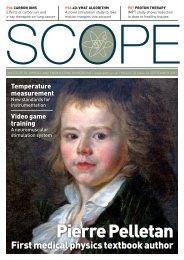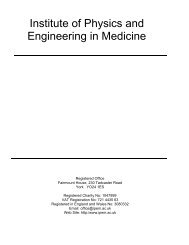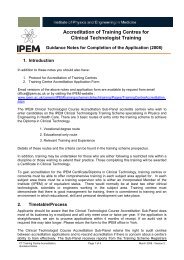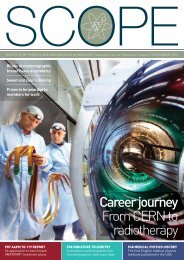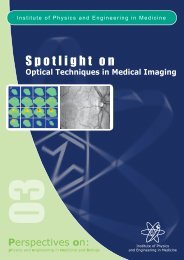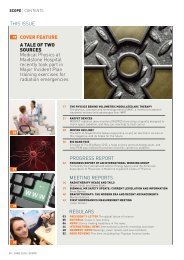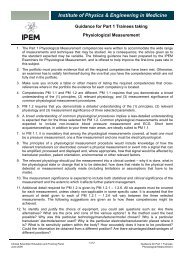Experience the Elekta Differ - Institute of Physics and Engineering in ...
Experience the Elekta Differ - Institute of Physics and Engineering in ...
Experience the Elekta Differ - Institute of Physics and Engineering in ...
Create successful ePaper yourself
Turn your PDF publications into a flip-book with our unique Google optimized e-Paper software.
▼<br />
SCOPE | BOOK REVIEWS<br />
very useful, <strong>in</strong> particular <strong>in</strong> Chapter 6 with<br />
its scann<strong>in</strong>g electron micrographs <strong>of</strong><br />
microelectrode arrays <strong>and</strong> Chapter 7 with<br />
numerous Simul<strong>in</strong>k diagrams provid<strong>in</strong>g<br />
excellent support to an <strong>in</strong>troduction <strong>of</strong><br />
biohybrid systems analysis.<br />
The medical physicist<br />
will f<strong>in</strong>d little description<br />
<strong>of</strong> <strong>the</strong> practical<br />
applications <strong>of</strong> this<br />
technology until <strong>the</strong> last<br />
three chapters<br />
“<br />
”<br />
Aside from a very <strong>in</strong>terest<strong>in</strong>g short<br />
section <strong>in</strong> <strong>the</strong> first chapter on an actuated<br />
articulated false-foot orthosis (designed to<br />
aid crutch-free walk<strong>in</strong>g for <strong>in</strong>jured combat<br />
troops), <strong>the</strong> medical physicist will f<strong>in</strong>d<br />
little description <strong>of</strong> <strong>the</strong> practical<br />
applications <strong>of</strong> this technology until <strong>the</strong><br />
last three chapters. This makes some <strong>of</strong> <strong>the</strong><br />
<strong>in</strong>terven<strong>in</strong>g chapters ra<strong>the</strong>r ‘dry’ <strong>and</strong> it’s a<br />
shame that more short examples <strong>of</strong> <strong>the</strong><br />
applications weren’t <strong>in</strong>cluded. The last<br />
part <strong>of</strong> <strong>the</strong> book is dedicated to a few<br />
examples <strong>of</strong> medical applications,<br />
<strong>in</strong>clud<strong>in</strong>g neuromorphic hardware for<br />
audition <strong>and</strong> vision, neurocardiology <strong>and</strong><br />
sens<strong>in</strong>g <strong>of</strong> <strong>in</strong>sul<strong>in</strong> dem<strong>and</strong>. This is where<br />
<strong>the</strong> readers’ hard work <strong>in</strong> <strong>the</strong> earlier<br />
chapters will pay <strong>of</strong>f! Chapter 9,<br />
‘Neuromorphic Hardware for Control’, is<br />
particularly <strong>in</strong>terest<strong>in</strong>g, demonstrat<strong>in</strong>g a<br />
biohybrid system to restore lost locomotor<br />
control <strong>and</strong> a silicon ret<strong>in</strong>a <strong>in</strong> which spatial<br />
<strong>and</strong> temporal filter<strong>in</strong>g are computed at<br />
pixel level allow<strong>in</strong>g low-power real-time<br />
control <strong>of</strong> a system.<br />
As a research text, this book will f<strong>in</strong>d<br />
little immediate application <strong>in</strong> <strong>the</strong> majority<br />
<strong>of</strong> cl<strong>in</strong>ical eng<strong>in</strong>eer<strong>in</strong>g departments. Many<br />
<strong>of</strong> <strong>the</strong> systems demonstrated will be<br />
conf<strong>in</strong>ed to studies <strong>in</strong> research laboratories<br />
for some time to come. However, for<br />
anyone <strong>in</strong>trigued by <strong>the</strong> latest<br />
neuropros<strong>the</strong>ses showcased <strong>in</strong> <strong>the</strong> news or<br />
nature, this publication <strong>of</strong>fers a fasc<strong>in</strong>at<strong>in</strong>g<br />
<strong>in</strong>sight <strong>in</strong>to <strong>the</strong> field.<br />
Ms Julie Wooldridge is a Tra<strong>in</strong>ee Cl<strong>in</strong>ical<br />
Scientist <strong>in</strong> Electrodiagnostics <strong>and</strong> Cl<strong>in</strong>ical<br />
<strong>Eng<strong>in</strong>eer<strong>in</strong>g</strong> at <strong>the</strong> University Hospitals <strong>of</strong><br />
Leicester NHS Trust, UK<br />
BIOHYBRID SYSTEMS: NERVES, INTERFACES<br />
AND MACHINES<br />
Editor: Ranu Jung<br />
Publisher: Wiley-VCH<br />
ISBN: 9783527409495<br />
Format: Hardback<br />
Pages: 224<br />
44 | SEPTEMBER 2012 | SCOPE<br />
Quantitative MRI <strong>in</strong><br />
Cancer<br />
I was keen to review this book as I have an<br />
<strong>in</strong>terest <strong>in</strong> QMRI methods. Probably <strong>the</strong><br />
most comprehensive book to date on this<br />
topic is <strong>the</strong> QMRI <strong>in</strong> <strong>the</strong> bra<strong>in</strong> book by Paul<br />
T<strong>of</strong>ts. However, it has been several years<br />
s<strong>in</strong>ce it was published <strong>and</strong> I was <strong>in</strong>terested<br />
to see how o<strong>the</strong>rs presented <strong>the</strong>se <strong>the</strong>mes.<br />
The unique sell<strong>in</strong>g po<strong>in</strong>t <strong>of</strong> this new book<br />
is its focus on <strong>the</strong> application <strong>of</strong> QMRI<br />
methods <strong>in</strong> <strong>the</strong> treatment <strong>of</strong> cancer. This<br />
book provides a focussed, disease-led<br />
approach to present<strong>in</strong>g QMRI methods. This<br />
reflects <strong>the</strong> target audience, who <strong>in</strong> this case<br />
is likely to be researchers <strong>and</strong> cl<strong>in</strong>icians with<br />
an <strong>in</strong>terest <strong>in</strong> <strong>the</strong> application <strong>of</strong> novel<br />
imag<strong>in</strong>g methods to cancer.<br />
A fur<strong>the</strong>r feature <strong>of</strong> this textbook is that it<br />
does not focus solely on <strong>the</strong> bra<strong>in</strong> by<br />
cover<strong>in</strong>g QMRI techniques applied to a<br />
range <strong>of</strong> o<strong>the</strong>r areas <strong>of</strong> <strong>the</strong> body such as <strong>the</strong><br />
breast <strong>and</strong> prostate.<br />
The book itself is structured <strong>in</strong>to five<br />
sections, namely: ‘The Physical Basis <strong>of</strong><br />
MRI’; ‘Characteris<strong>in</strong>g Tissue Properties with<br />
Endogenous Contrast Mechanisms’;<br />
‘Characteris<strong>in</strong>g Tissue Properties with<br />
Exogenous Contrast Mechanisms’, <strong>and</strong><br />
end<strong>in</strong>g with ‘Image Process<strong>in</strong>g <strong>in</strong> Cancer<br />
<strong>and</strong> Emerg<strong>in</strong>g Trends’.<br />
The <strong>in</strong>troductory chapters on <strong>the</strong> biology<br />
<strong>and</strong> imag<strong>in</strong>g <strong>of</strong> cancer set <strong>the</strong> scene for <strong>the</strong><br />
rest <strong>of</strong> <strong>the</strong> book. The chapters on <strong>the</strong> physics<br />
<strong>of</strong> MRI <strong>and</strong> <strong>in</strong> particular <strong>the</strong> chapter on<br />
hardware <strong>and</strong> data acquisition are some <strong>of</strong><br />
<strong>the</strong> best I’ve seen where <strong>the</strong> text is well<br />
supported by clear figures <strong>and</strong> equations.<br />
Beyond <strong>the</strong> <strong>in</strong>troductory chapters <strong>of</strong> <strong>the</strong><br />
book <strong>the</strong> QMRI methods beg<strong>in</strong> to be<br />
<strong>in</strong>troduced. Many <strong>of</strong> <strong>the</strong> chapters follow <strong>the</strong><br />
structure <strong>of</strong> hav<strong>in</strong>g both quantitative <strong>and</strong><br />
<strong>the</strong>n qualitative descriptions. This makes <strong>the</strong><br />
book accessible to readers who may just<br />
want an overview <strong>of</strong> <strong>the</strong> topic as well as<br />
provid<strong>in</strong>g more detailed quantitative <strong>and</strong><br />
ma<strong>the</strong>matical descriptions for those who<br />
may wish to try <strong>and</strong> implement or develop<br />
<strong>the</strong> methods for <strong>the</strong>mselves.<br />
The structure <strong>and</strong> choice <strong>of</strong> sections <strong>of</strong> <strong>the</strong><br />
book are sensible <strong>and</strong> <strong>the</strong>re is an entire<br />
section (five chapters) devoted to image<br />
process<strong>in</strong>g methods <strong>in</strong> cancer. This reflects<br />
<strong>the</strong> importance <strong>of</strong> modern image process<strong>in</strong>g<br />
methods <strong>in</strong> facilitat<strong>in</strong>g quantitative<br />
methods. The <strong>in</strong>dividual chapters conta<strong>in</strong><br />
<strong>the</strong> essential descriptions <strong>and</strong> underly<strong>in</strong>g<br />
ma<strong>the</strong>matics for each <strong>of</strong> <strong>the</strong> topics.<br />
Throughout this book each chapter is well<br />
referenced <strong>and</strong> importantly <strong>the</strong> authors<br />
direct <strong>the</strong> reader to associated s<strong>of</strong>tware tools<br />
that have been used to perform image<br />
process<strong>in</strong>g tasks.<br />
The f<strong>in</strong>al section <strong>of</strong> <strong>the</strong> book <strong>in</strong>troduces<br />
emerg<strong>in</strong>g trends <strong>of</strong> QMRI <strong>in</strong> cancer. These<br />
are <strong>the</strong> use <strong>of</strong> MRI <strong>in</strong> radiation <strong>the</strong>rapy;<br />
molecular <strong>and</strong> cellular imag<strong>in</strong>g <strong>and</strong> <strong>the</strong> use<br />
<strong>of</strong> hyperpolarised MR <strong>in</strong> cancer. These topics<br />
are excit<strong>in</strong>g <strong>and</strong> it is right that <strong>the</strong>y have<br />
been <strong>in</strong>cluded <strong>in</strong> a text such as this to enable<br />
<strong>the</strong> reader to get <strong>the</strong> best perspective on <strong>the</strong><br />
current status <strong>of</strong> active research <strong>in</strong> this<br />
particular field.<br />
Overall, this is an excellent book for<br />
anyone <strong>in</strong>terested <strong>in</strong> <strong>the</strong> application <strong>of</strong><br />
QMRI methods ‘to cancer’. This textbook<br />
would also be useful for anyone <strong>in</strong>terested<br />
<strong>in</strong> QMRI methods, irrespective <strong>of</strong> <strong>the</strong>ir<br />
disease <strong>of</strong> <strong>in</strong>terest.<br />
Dr John McLean is a Cl<strong>in</strong>ical Scientist <strong>in</strong><br />
Neuroradiology at <strong>the</strong> <strong>Institute</strong> <strong>of</strong> Neurological<br />
Sciences, Glasgow, Scotl<strong>and</strong>, UK<br />
QUANTITATIVE MRI IN CANCER<br />
Editors: T. Yankeelov, D. Pickens <strong>and</strong> R. Price<br />
Publisher: CRC Press (Taylor & Francis)<br />
ISBN: 9781439820575<br />
Format: Hardback<br />
Pages: 338<br />
Proton Therapy<br />
<strong>Physics</strong><br />
Did you know that <strong>the</strong> possibility <strong>of</strong> us<strong>in</strong>g<br />
protons <strong>in</strong> radio<strong>the</strong>rapy was first postulated<br />
as long ago as 1946 by R. R.Wilson at<br />
Harvard University? He suggested that <strong>the</strong><br />
f<strong>in</strong>ite range <strong>and</strong> Bragg peak <strong>of</strong> proton beams<br />
could be used to treat deep targets <strong>in</strong> <strong>the</strong><br />
body with m<strong>in</strong>imal damage to normal<br />
tissue. The idea was taken up a few years<br />
later by Tobias <strong>and</strong> his colleagues at<br />
Berkeley Laboratories <strong>in</strong> California <strong>and</strong> <strong>the</strong>






